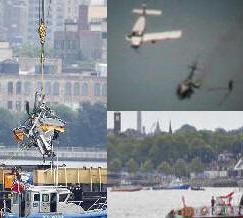|
|||||||||||
|
|
|
|||
|
By Jim Douglas |
||||
 |
September 16, 2010
- The National Transportation Safety Board today determined that the
probable cause of last year's
midair collision over the Hudson River that resulted in the deaths
of all nine persons aboard the two aircraft were the inherent
limitations of "see-and-avoid" concept and a Teterboro Airport air
traffic controller's nonpertinent telephone conversation at the time of
the collision.
The see-and-avoid
technique of averting mid-air collisions was not effective because of
the difficulty the airplane pilot had in seeing the helicopter until the
final seconds before the collision.
In addition, the |
|||
|
|
||||
|
The Safety Board
met today in a five-hour public meeting to determine the probable cause
of the accident and issued five recommendations to the Federal Aviation
Administration for improving the safety of the national airspace, and in
particular, the airspace over the Hudson River near New York City.
The Safety Board
noted that contributing to the cause of the accident were the
ineffective use by both pilots of their aircrafts' electronic advisory
system to maintain awareness of other air traffic, FAA's procedures for
transfer of communications among air traffic facilities near the Hudson
River, and FAA regulations that did not provide for adequate vertical
separation of aircraft operating over the Hudson River.
On August 8, 2009,
a Piper PA-32R-300 airplane, N71MC, and a Eurocopter AS350BA helicopter,
N401LH, operated by Liberty Helicopters, collided over the Hudson River
near |
||||


